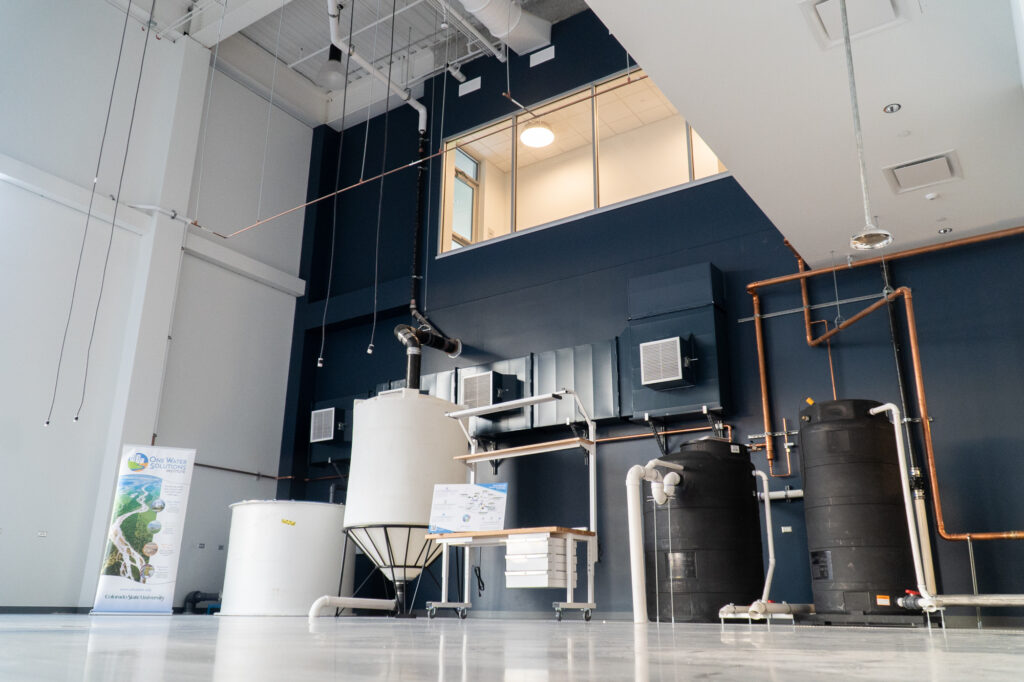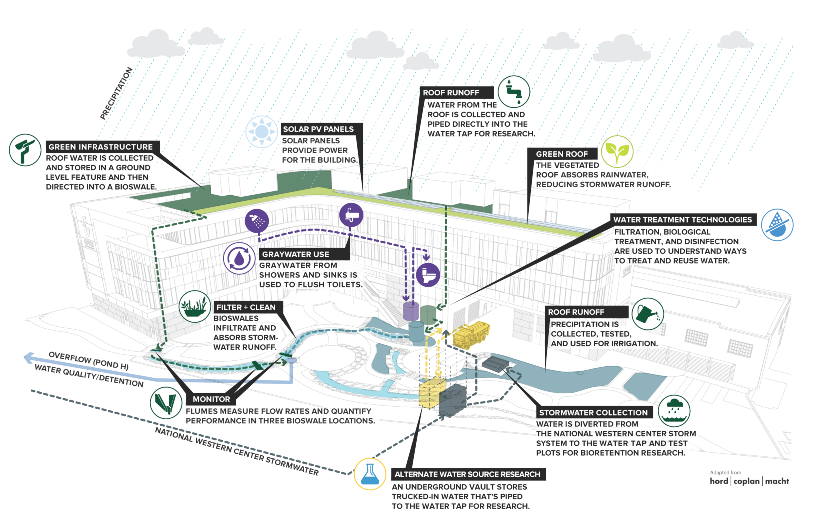Cutting edge water treatment technology
The first of its kind, this cutting-edge facility is a platform for testing new water treatment technologies on different water sources to study the best ways we can clean and reuse water.
The Water Technology Acceleration Platform (“The Water TAP”) is a state-of-the-art laboratory space designed to propel water technology from research prototypes to market-ready (commercial) products.
The Water TAP is currently being developed for innovations to be tested – removing the barrier for new inventors, researchers, and growing companies to advance, test, and go-to- market with new water treatment technology.
The Water TAP currently provides access to five different onsite water sources at flow rates near 1000 gallons per day with an additional capacity to include other sources as needed:
- Urban stormwater
- Graywater
- Raw water (South Platte River)
- Rainwater (roof runoff)
- Recycled wastewater
In addition, the facility includes a large space to connect water sources to treatment systems for testing.

Water TAP research
In this lab, researchers at the One Water Solutions Institute test different water sources with a variety of advanced water treatment technologies. Here, scientists can find the best treatment method to match how the treated water will be used. OWSI experts explore technologies such as filtration, biological treatment, and disinfection to understand new and better ways to treat and reuse water. These experiments also help lawmakers determine policies to put into place for reusing and conserving water.

Focus areas
Currently, the Water TAP is focused on the following programmatic areas with plans to expand the portfolio of offerings as new projects, collaboration opportunities, and resources become available:
Stormwater capture and use
- Onsite stormwater treatment systems
- Treatment trains (fit-for-purpose end use)
- Rainwater harvesting (roof runoff/rain barrels)
Green infrastructure
- Bioswale runoff reduction/monitoring
- Rain gardens
- Bioretention testing
- Green roofs (Hydro & Terra)
Water treatment technologies
- Membrane filtration and ultrafiltration
- Biological treatment
- Ultraviolet treatment
- Microbial treatment
Water sources – a “one stop shop”
- Numerous possibilities for research and development, testing, training, and validation
One Water systems and circular water economy
Project team
The team currently leading the facility launch includes Sybil Sharvelle (Professor, Civil & Environmental Engineering and Technical Director, Water TAP), Mazdak Arabi (Professor, Civil & Environmental Engineering and Director, One Water Solutions Institute), and Sarah Millonig (Director of Operations, One Water Solutions Institute). The Water TAP laboratory manager is Todd Shollenberger.
Interested in learning more or collaborating?
Get in touch with our team at owsi@colostate.edu or check out our website!

Research Brief: Stormwater Test Plots
In a collaborative research project jointly funded by the Mile High Flood District and City and County of Denver, CSU researchers are advancing innovations in stormwater management in Spur’s Backyard which functions as a unique “living laboratory”. Experiments will occur in two specially designed test plots that mimic streetside planters commonly used in urban landscapes along the Front Range.
These experimental plots are filled with soil mixtures and vegetation typically installed in streetside planters across the Denver area. The plots include built-in systems to irrigate the plants using stormwater runoff collected onsite and sampling equipment to gather data on water quality, flow rates, plant health, and other important performance-related information.
The test plots are filled with soil mixtures (planting media) and vegetation (plants) typically installed in streetside planters and include:
- A system to collect raw stormwater from the storage vault adjacent to the site and apply it to the test plots to simulate runoff
- An irrigation system with application rates that mimic rain events using potable water
- Automated water quality samplers to collect effluent and measure flow rates
In addition, this study will evaluate use of stormwater on the green roof and rooftop agrivoltaic system located on the roof of Hydro. This portion of the study will investigate the potential for stormwater capture and treatment on green roofs while providing irrigation for the plants.
Test plots: The experiments will take place in two specially designed, concrete test plots in the Backyard of the Hydro Building at the CSU Spur Campus.
- Concrete test plots are located on the southeast side of the Spur Backyard.
- Stormwater runoff is collected onsite from adjacent National Western Center, commercial, industrial, and residential areas. The test plots are connected to the underground stormwater storage tank also located in the Backyard.
Green roof & agrivoltaic system: The Hydro rooftop houses an extensive photovoltaic system, an array of solar panels that use energy from the sun to generate electricity. Planters are located directly below the solar panels providing simultaneous power generation and plant or edible crop production. These are commonly referred to as “agrivoltaic” or “argisolar” systems. This system is not publicly accessible, but guests can stop by the green roof on Terra to visit a living rooftop garden.
